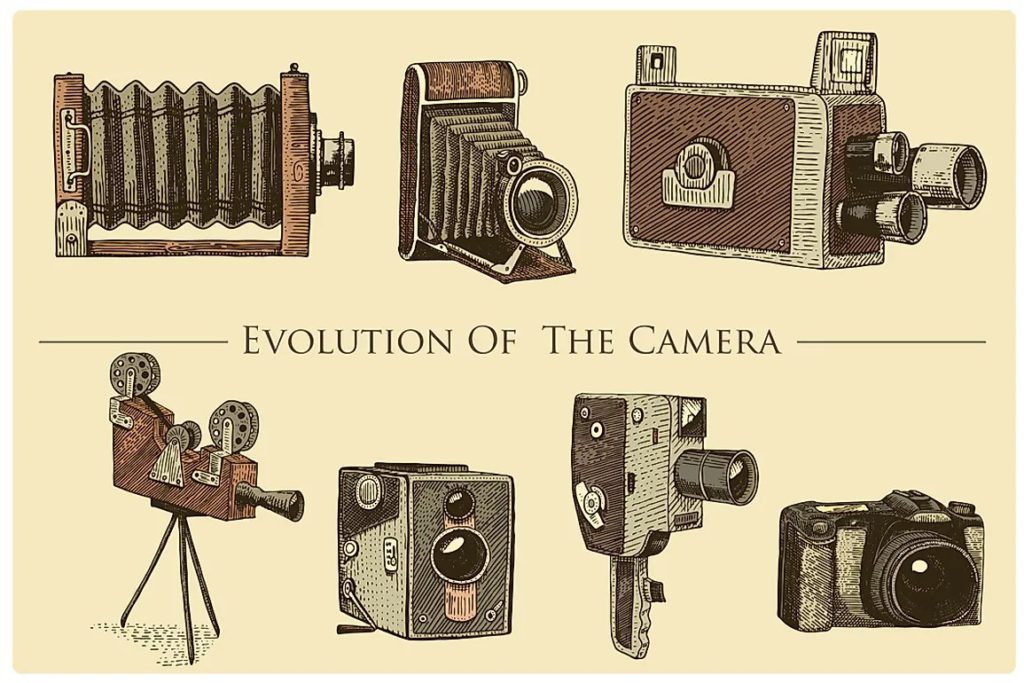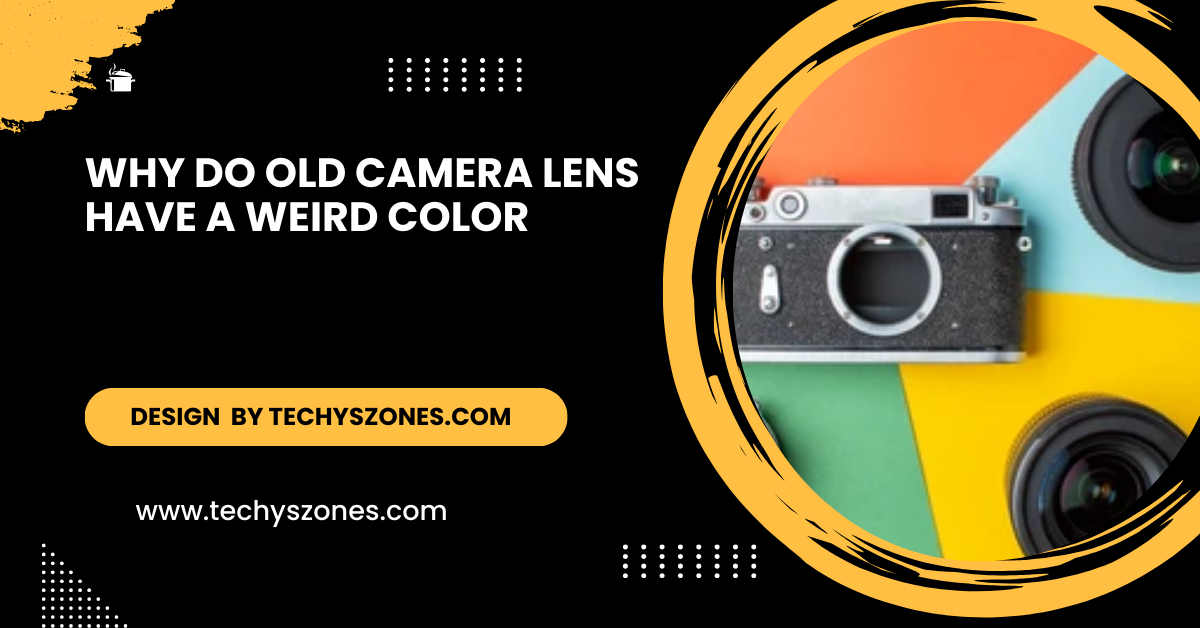Why Do Old Lens Camera Lens Have A Weird Color – Unveiling The Mystery!
Old camera lenses often have a weird color due to the unique coatings and glass compositions used in their construction, which can create tints like green, purple, or amber.
In this article, we’ll delve into the fascinating reasons behind the coloration of old camera lenses, shedding light on the interplay of materials, coatings, and the passage of time. Additionally, aging, environmental factors, and impurities in the glass can lead to discoloration over time.
The Evolution of Camera Lenses:

To understand why old camera lenses have a weird color, it’s essential to appreciate the evolution of lens technology. The history of photography dates back to the early 19th century, when the first photographic processes were developed. Early lenses were made of simple glass elements and lacked the sophisticated coatings and designs found in modern optics. As photography evolved, so did lens technology, with advances in materials, coatings, and manufacturing techniques.
Early Lens Designs:
Initially, camera lenses were crafted using uncoated glass, which resulted in significant light loss and reflections. As photographers sought to improve image quality, lens manufacturers began experimenting with different types of glass and lens shapes. This led to the introduction of multiple lens elements, which helped to correct optical aberrations and improve image sharpness.
The Introduction of Coatings:
In the mid-20th century, manufacturers started applying anti-reflective coatings to lens surfaces. These coatings not only enhanced light transmission but also reduced glare and ghosting effects.While modern lenses feature advanced multi-coatings, older lenses often employed simpler coatings that imparted distinctive colors to the glass.
The Role of Lens Coatings:
One of the primary reasons old camera lenses exhibit weird colors is the coatings used on their surfaces. These coatings are crucial for optimizing the lens’s performance, and their composition can significantly affect the lens’s appearance.
Types of Coatings:
Coatings are typically categorized into two main types: single-layer and multi-layer coatings.
- Single-Layer Coatings: These were among the first coatings developed. They involve applying a single thin layer of a specific material to the lens surface. While effective at reducing reflections, they can impart a noticeable color tint to the lens.
- Multi-Layer Coatings: As technology advanced, manufacturers began to use multiple layers of different materials, allowing for more efficient light transmission and further reduction of reflections. These coatings can create complex interference patterns, resulting in various colors depending on the viewing angle and lighting conditions.
Color Appearance:
The color that appears on the lens surface is a result of the interference of light waves reflecting off the coated surfaces. For example, a lens with a blue coating may appear blue when viewed from certain angles. Similarly, green or purple tints may result from specific multi-coating combinations.
The Glass Composition:
The composition of the glass used in old camera lenses also plays a significant role in the colors observed. Historically, lens manufacturers utilized different types of glass, some of which contained impurities or additives that could affect their optical properties.
Types of Glass:
- Crown and Flint Glass: These were commonly used materials in lens manufacturing. Crown glass is known for its clarity and low dispersion, while flint glass has a higher refractive index but can also introduce color fringing in images.
- Optical Glass: Advances in materials science led to the development of specialized optical glass with specific properties tailored for photography. However, many older lenses were made with glass that may have had inconsistencies, leading to color shifts in the images produced.
Impurities and Additives:
The presence of impurities in the glass can create distinct color casts. For example, certain iron impurities can lead to a greenish hue, while other elements can impart yellow or amber tones. Additionally, some lenses use lead-based glass, which has unique refractive qualities that can alter the perceived color.
Read More: Flutter Camera Gradle Error – Expert Tips and Techniques!
Aging and Degradation:
Time has a profound impact on camera lenses. As lenses age, they undergo various changes that can affect their appearance and performance. This aging process can lead to discoloration or a change in the perceived color of the lens.
Environmental Factors:
Older lenses may have been exposed to various environmental factors over the years, including UV light, humidity, and temperature fluctuations. These factors can degrade lens coatings and even the glass itself, leading to discoloration.
- UV Exposure: Ultraviolet light can break down lens coatings and cause yellowing or clouding of the glass.
- Humidity and Temperature: High humidity levels can lead to the development of fungus on the lens elements, while extreme temperature changes can cause stress on the glass and coatings, resulting in a loss of clarity and color.
Chemical Changes:
Chemical changes can also affect the appearance of old lenses. The breakdown of lens coatings or reactions between the glass and environmental pollutants can lead to yellowing or other color changes. Some lenses may even develop a milky appearance, obscuring their original hue.
Chromatic Aberration and Color Rendering:

Another factor contributing to the perception of weird colors in old lenses is chromatic aberration. This optical phenomenon occurs when a lens fails to focus all colors to the same convergence point, leading to color fringing in images.
Understanding Chromatic Aberration:
Chromatic aberration occurs because different wavelengths of light refract differently when passing through a lens. This can result in color fringing, where the edges of subjects appear colored—often with a halo effect of purple or green.
Artistic Color Rendering:
While chromatic aberration is generally seen as a flaw, many photographers appreciate the unique color rendering of vintage lenses. The imperfect optics can produce images with character, offering a distinct aesthetic that modern lenses often lack. This artistic quality is highly sought after in certain photography genres, such as portraiture and street photography.
Collectibility and Aesthetic Appeal:
The quirky colors and unique optical characteristics of old camera lenses have made them highly collectible among photography enthusiasts. Many photographers actively seek out vintage lenses to achieve specific looks or artistic effects in their work.
Nostalgia and Vintage Photography:
The nostalgia associated with using vintage equipment adds to their allure. Photographers often enjoy the tactile experience of using older lenses and the connection to the history of photography. The unique colors and imperfections can evoke a sense of timelessness and authenticity in images.
Lens Modifications and Adaptations:
Many photographers modify old lenses for modern camera systems, creating a bridge between the past and the present. These adaptations allow enthusiasts to enjoy the aesthetic qualities of vintage lenses while benefiting from the advancements in modern camera technology. The process of adapting and using these lenses can be an exciting exploration in creativity.
FAQs:
- Why do old camera lenses have different colors?
Old camera lenses have different colors due to coatings applied during manufacturing and the types of glass used, which can introduce tints.
- What causes discoloration in vintage lenses?
Discoloration in vintage lenses is often caused by aging, exposure to UV light, humidity, and environmental pollutants that degrade coatings and glass.
- Are the weird colors in old lenses harmful to photos?
While some color shifts may affect image quality, many photographers appreciate these colors for their unique aesthetic and character.
- Can I restore the original color of an old lens?
Restoring the original color can be challenging and may require professional cleaning, but it’s often the unique color that adds charm to vintage lenses.
- Why do photographers still use old lenses with weird colors?
Photographers use old lenses for their distinctive visual qualities, including unique bokeh and color rendering, which can create artistic effects not found in modern lenses.
Conclusion:
Old camera lenses are a testament to the rich history of photography and the evolution of optical technology. Their weird colors, resulting from coatings, glass composition, aging, and optical phenomena, offer a glimpse into the craftsmanship of the past. While modern lenses provide incredible sharpness and clarity, vintage lenses bring character and artistic expression to photography.







